MATTERS OF OBSESSION
Beyond Borders: The Journey of Nyambo MasaMara, Rwandan-born artist and fashion designer
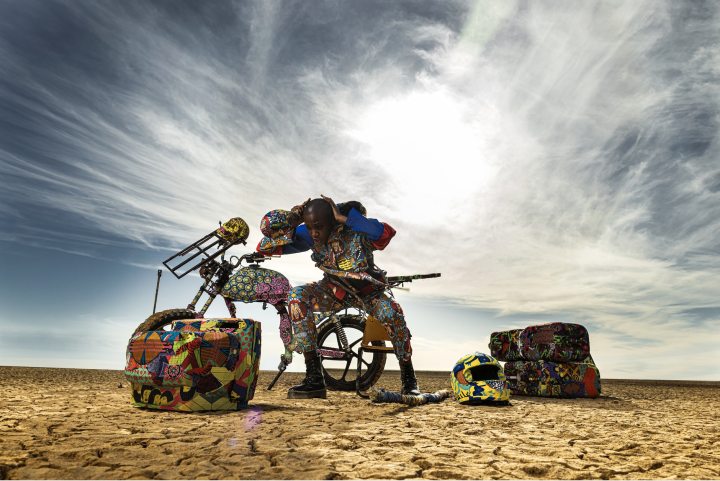
For Eli Gold, it has been a long journey, from the far side of the Rwandan genocide to his debut exhibition, ‘Beyond Borders’, which opened in Cape Town on 17 April 2021 as part of a group exhibition at the Jaffer Modern Gallery.
There is something magical about Eli Gold. His gentle, welcoming, demeanour and the glittering light beaming from his active eyes attract people towards him. But then, it is not difficult to notice the fashion designer behind the brand MasaMara, and the artist, Nyambo MasaMara, in a crowd. He is the slight young man in hyper-colourful clothing whose hair curves around his face in the shape of two impressive long horns – the statuesque long horns of the Rwandan royal cow (inyambo). This is just one of the many facets of the designer, artist and life-traveller.
Born to a mixed-heritage Rwandan family in 1992, one of 13 children, the journey started when the family fled the genocide in 1994, landing in refugee villages in the neighbouring Democratic Republic of Congo. Although his family returned to their original homestead, in their brutally transformed homeland, the young Gold still had many journeys to travel; and it is around those journeys – and the many layers of images, objects, symbols and totems that the traveller is confronted with – that his body of fashion and artwork revolves.
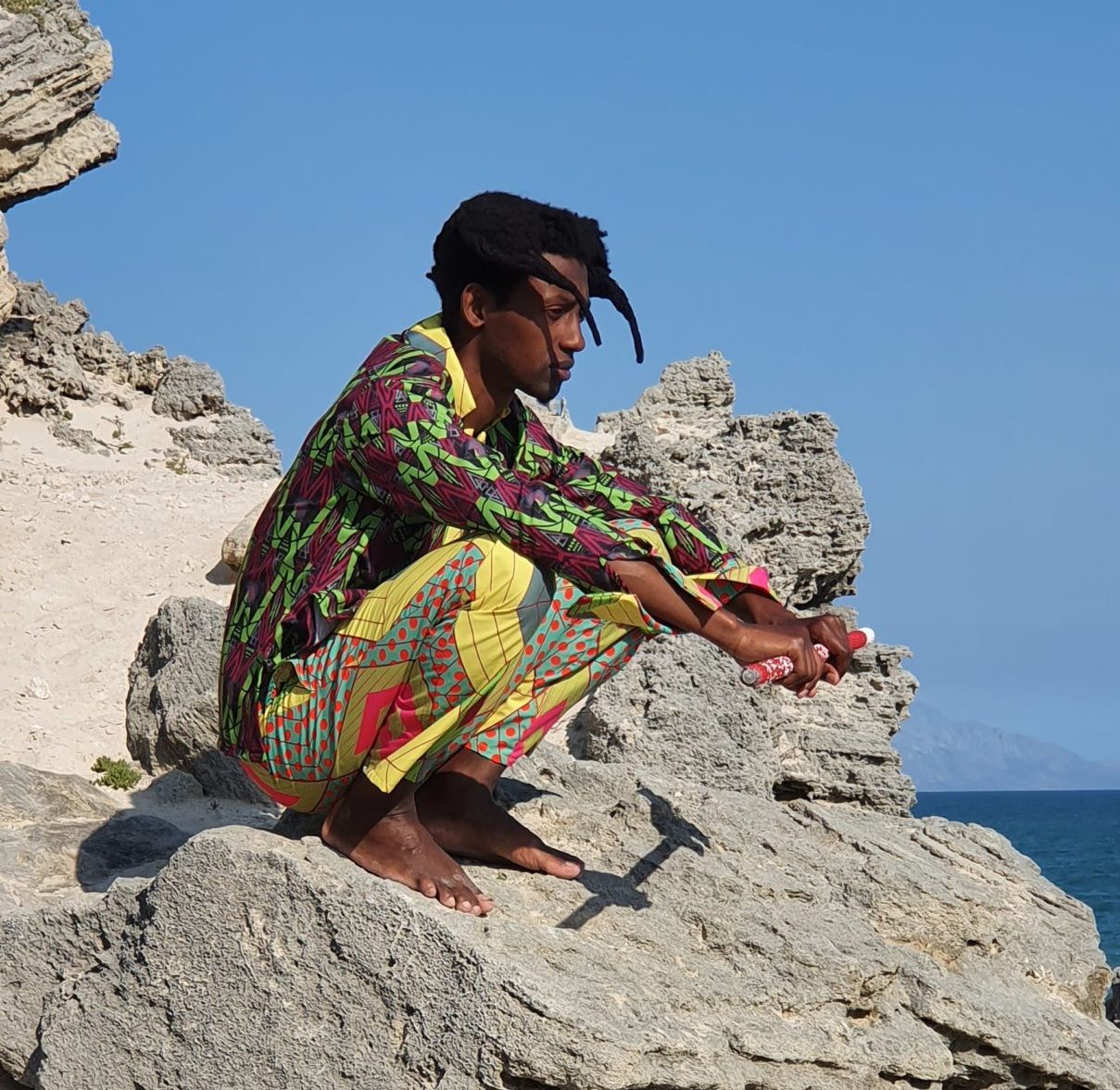
Eli Gold on a fashion shoot, 2020 (Photo supplied).
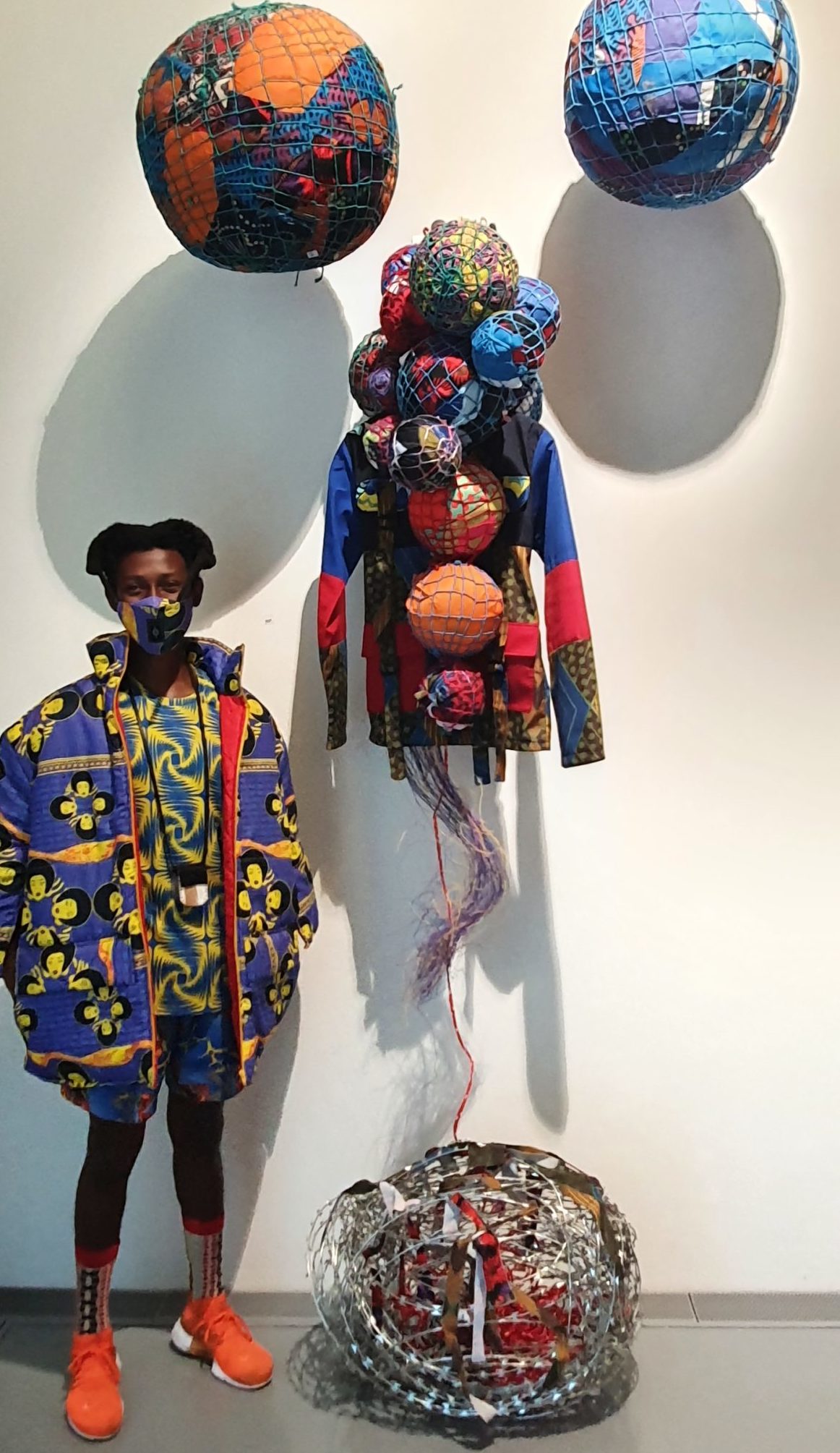
Eli Gold for Jaffer Modern (Photo supplied).
It was at the age of 13 that Gold was sent off by his mother to travel solo across the African continent and to start a new life with his brother, who was working in South Africa, initially as a car guard at the Blue Route Mall in Cape Town. One day, Gold’s brother, who was serving as a security guard at a home in Llandudno, acted with bravery and vision and saved a house from the ravages of fire. When the grateful owners proffered a reward, Gold’s brother asked for nothing more than a school uniform for his younger sibling. The couple opted to pay for Eli Gold’s fees – right up to matriculation and beyond – at False Bay College in Fish Hoek, where he completed a diploma in business management. They served as surrogate parents and mentors until they returned to their Dutch homeland about five years ago.
On graduation, Gold found employment in a junior position at a development finance organisation in Cape Town. But he had a calling: On weekends he worked for a city sportswear importer and soon began designing artwork for sweatshirts. And when these sold, he apprenticed himself to a tailor to learn all he could about cut, fabric and fit. The call of colour, fabric, clothing and fashion was just too strong: he left the world of numbers to assume the mantle of his beloved mother, who, he recalls, would traverse East Africa, buying and selling African fabrics.
The emergence of a designer
For Gold, the lure of fabric and colour was not simply to form spectacular outfits from the thousands of wax-print patterns that define Africa (but are designed by Dutch manufacturer Vlisco, using the ancient batik techniques of Indonesia). He designed his own bright geometric repetitive patterns, digitally transposed to fabric, each work a signature piece, depicting for the artist an intimate symbolic aspect of his life journey, and for the wearer a splash of individuality in a sea of fashion conformity.
Very soon, the young fabric designer was plying his trade as Eli Gold, fashion designer. Eli Gold is not his birth name, but an optimistic name he assumed when he burst onto the South African creative landscape as a fabric and fashion designer. His inspiration came from his East African and pan-African experiences; his design style was uniquely contemporary, gender neutral and gorgeous to wear.

MasaMara, ‘African Nomads’ (Photo supplied).
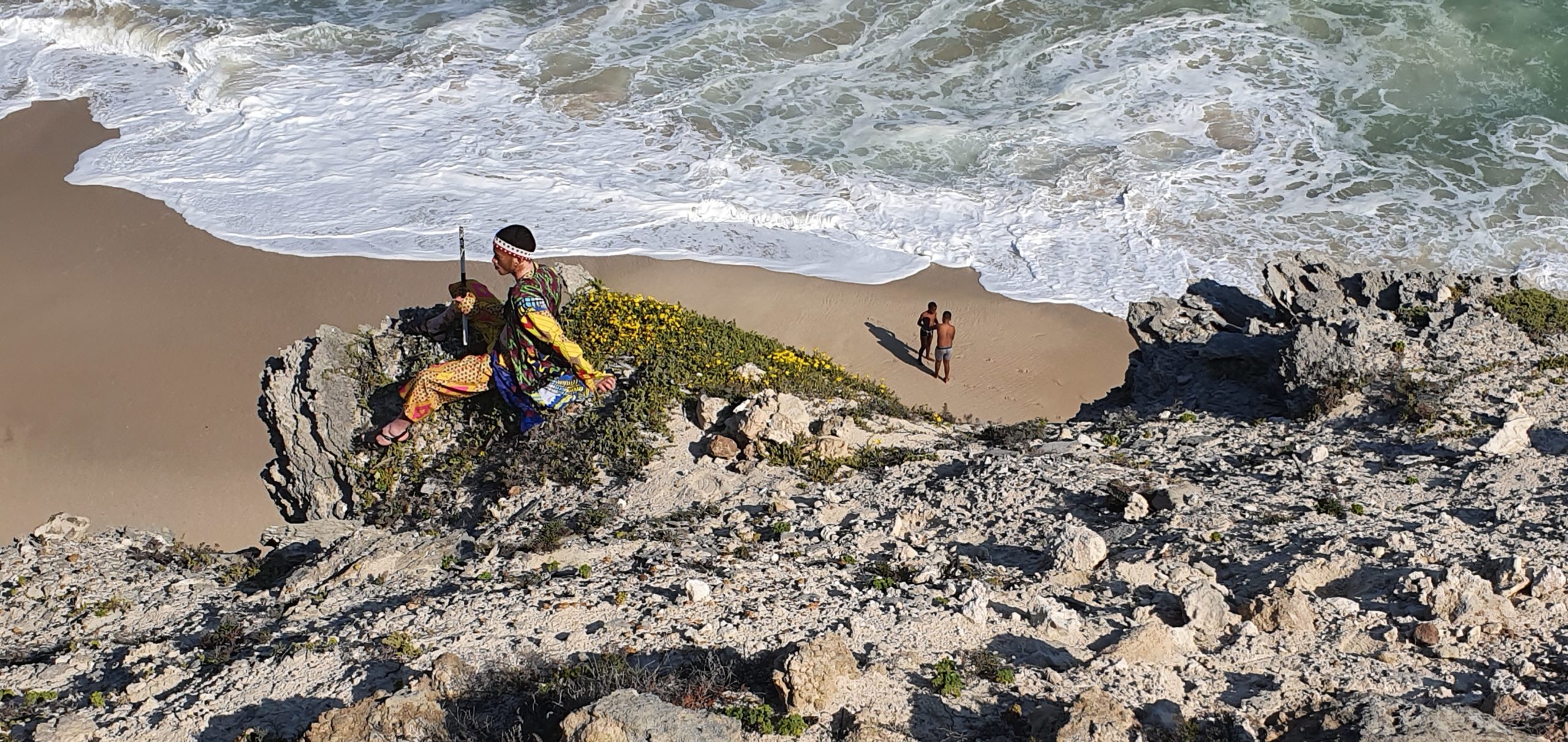
MasaMara. ‘Nomad Outlook’ (Photo supplied).

MasaMara. Outcrop (Photo supplied).
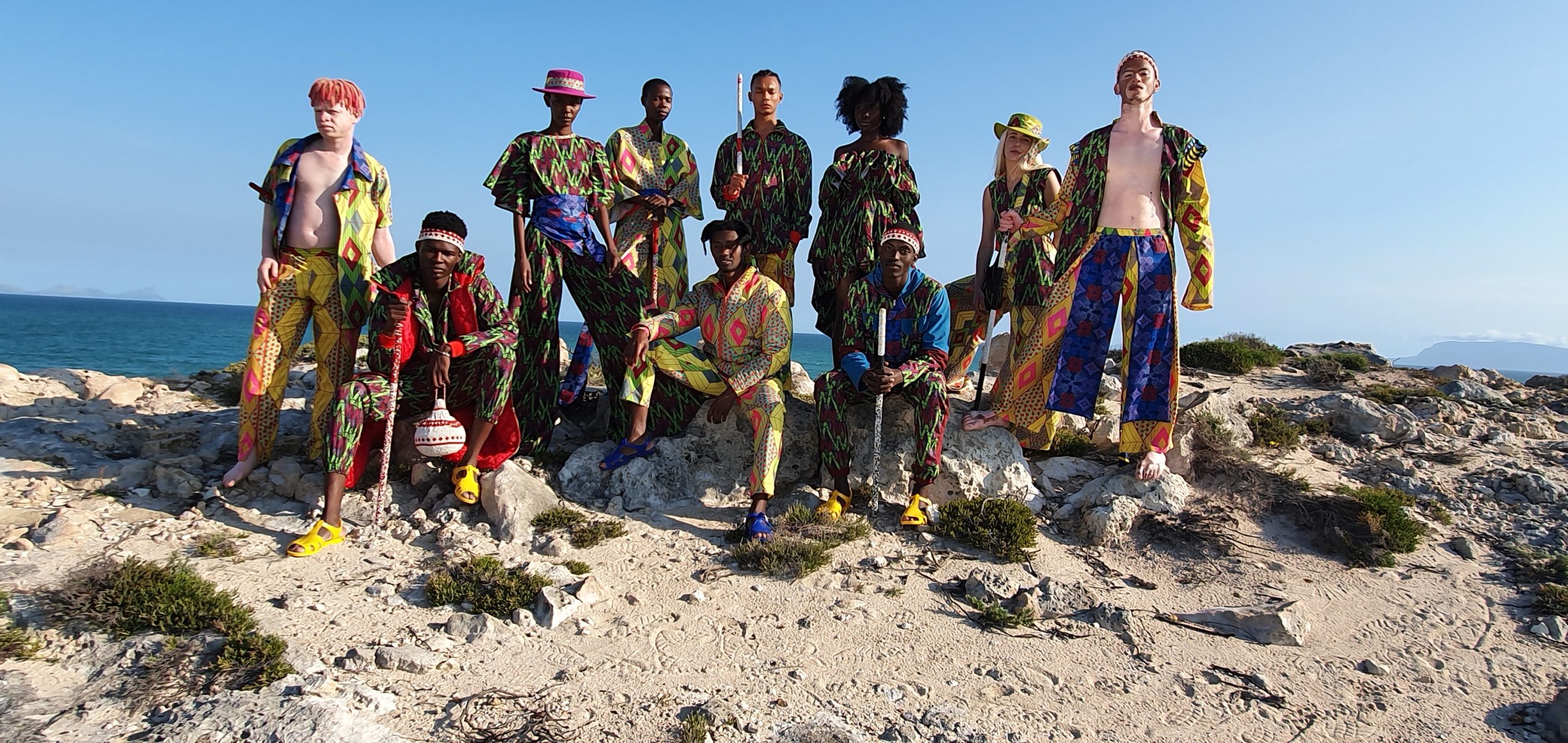
MasaMara. (Photo supplied).
Later, he ploughed away at his chosen calling and turned his hand to performative work: for the 2018 Investec Cape Town Art Fair, a MasaMara troupe of models and performers, interlocked with woven bands, appeared as a flash mob for a walk-through performance.
Emboldened by the reception at the art fair, Gold took the MasaMara performance to the 2018 South African Menswear Week Autumn/Winter show; he was invited back as an official designer for the July 2020 spring/summer show. Design Indaba 2019 also “played host” to a MasaMara Performance, as did the Rugby Trophy Tour of 2019, and for the prestigious Sun Met in 2020 MasaMara featured as the guest designer for Miss South Africa, who was the face of the campaign.
And then came Covid-19. Gold continued creating, undeterred.
Beyond Borders
It was during lockdown that Gold made the leap to visual artist. Spurred on by a mentor, he submitted a work to the post-lockdown Home is Where the Art Is | Art is Where the Home Is exhibition at Zeitz MOCAA in late 2020. Including one of his own spectacular jackets from his then-current collection, and some remastered props, the work Refugee | Refused – Refuge | Refuse hearkens to the tough journey undertaken by all refugees.

Behind the scenes. Nyambo MasaMara, Beyond Borders, 2021 (Photograph supplied)
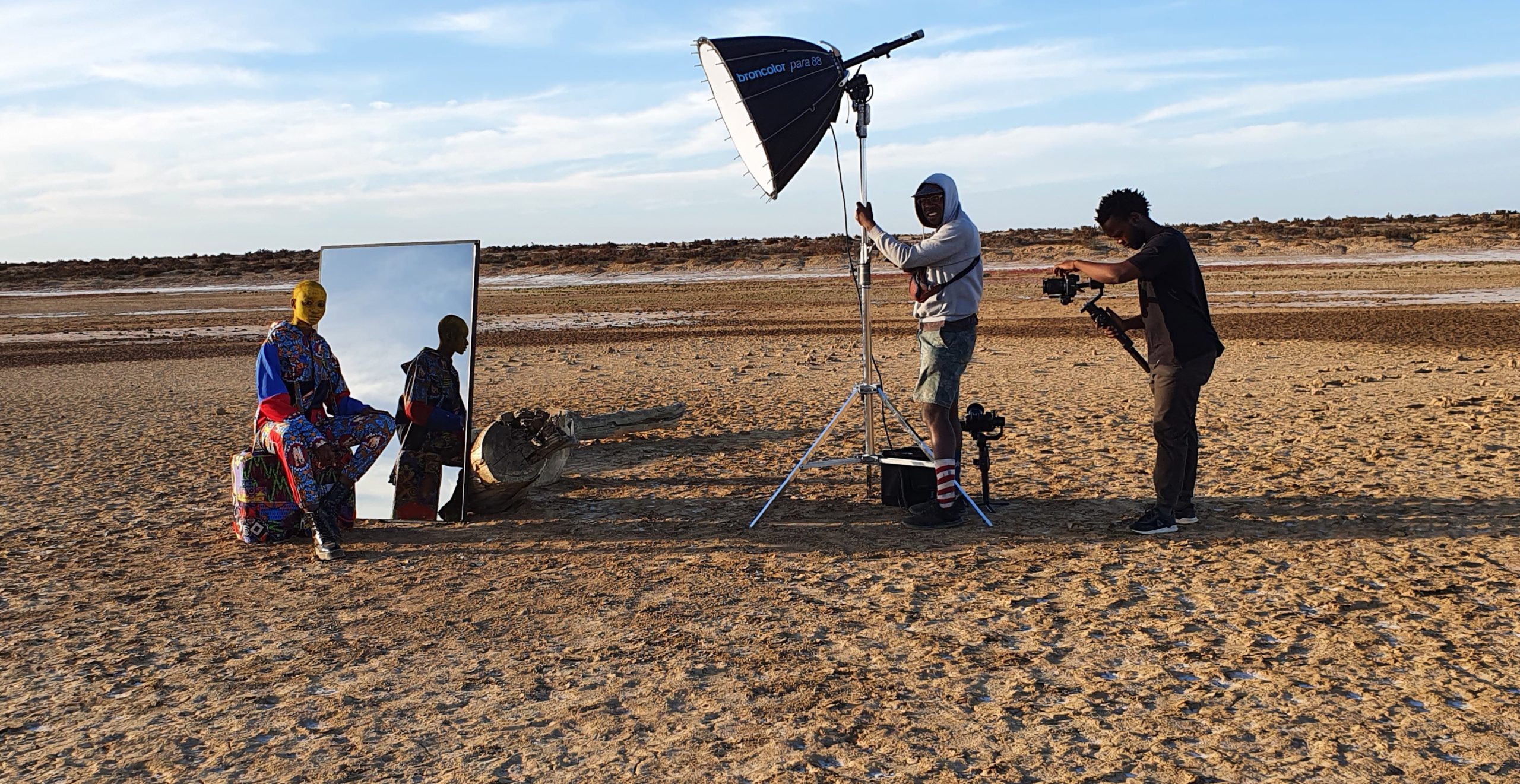
Behind the scenes. Nyambo MasaMara, Beyond Borders, 2021 (Photograph supplied)
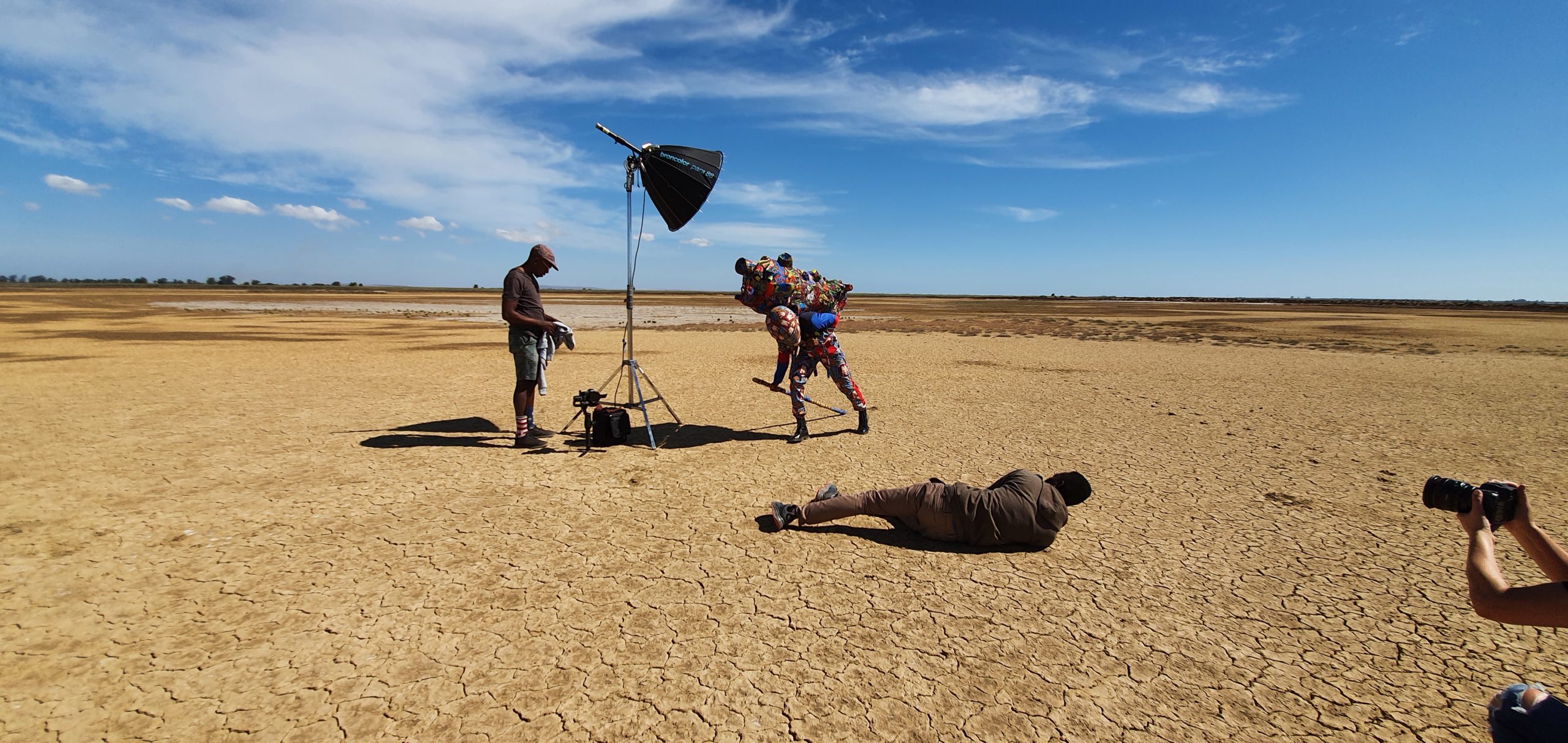
Behind the scenes. Traveller. Nyambo MasaMara, Beyond Borders, 2021 (Photograph supplied)
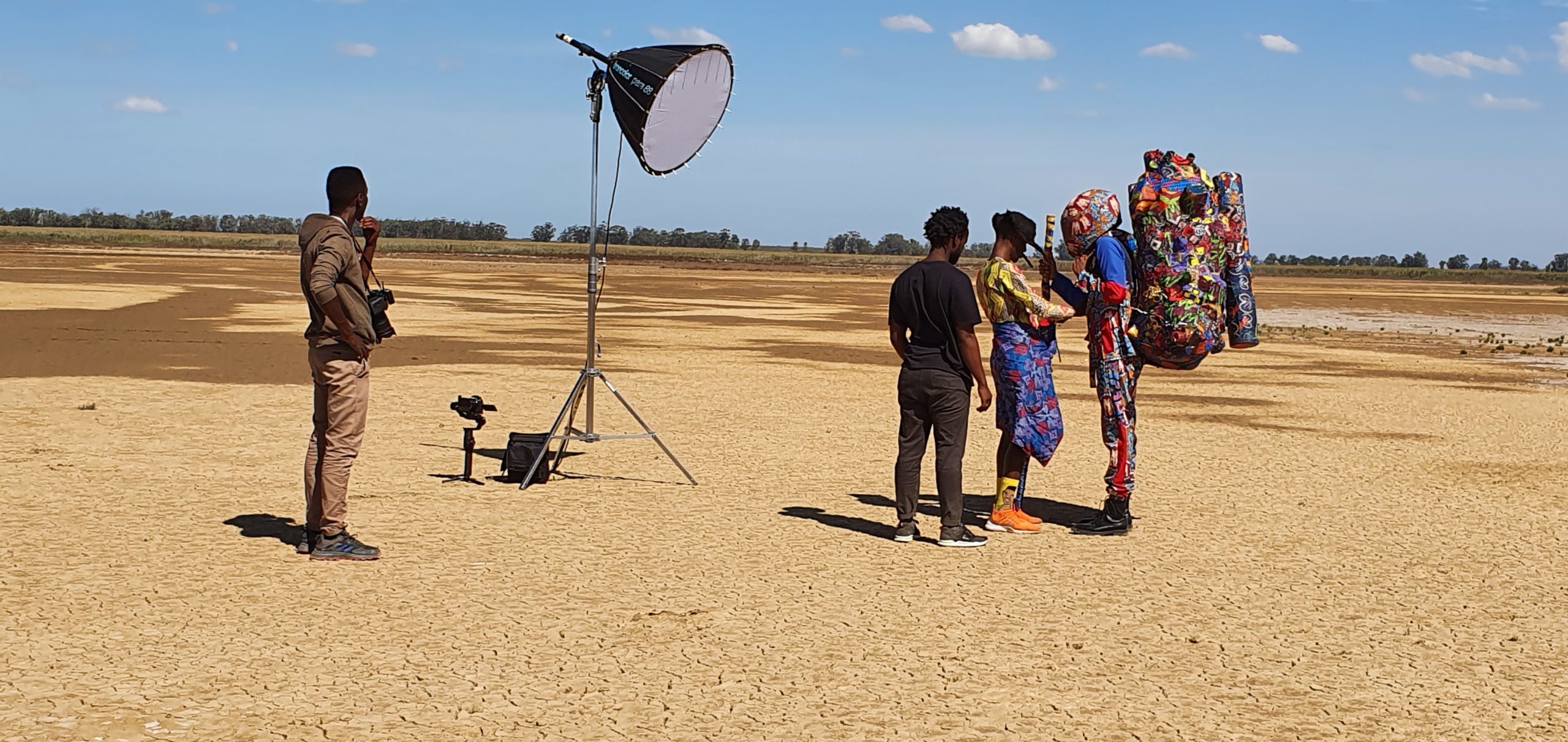
Behind the scenes. Nyambo MasaMara, Beyond Borders, 2021 (Photograph supplied)
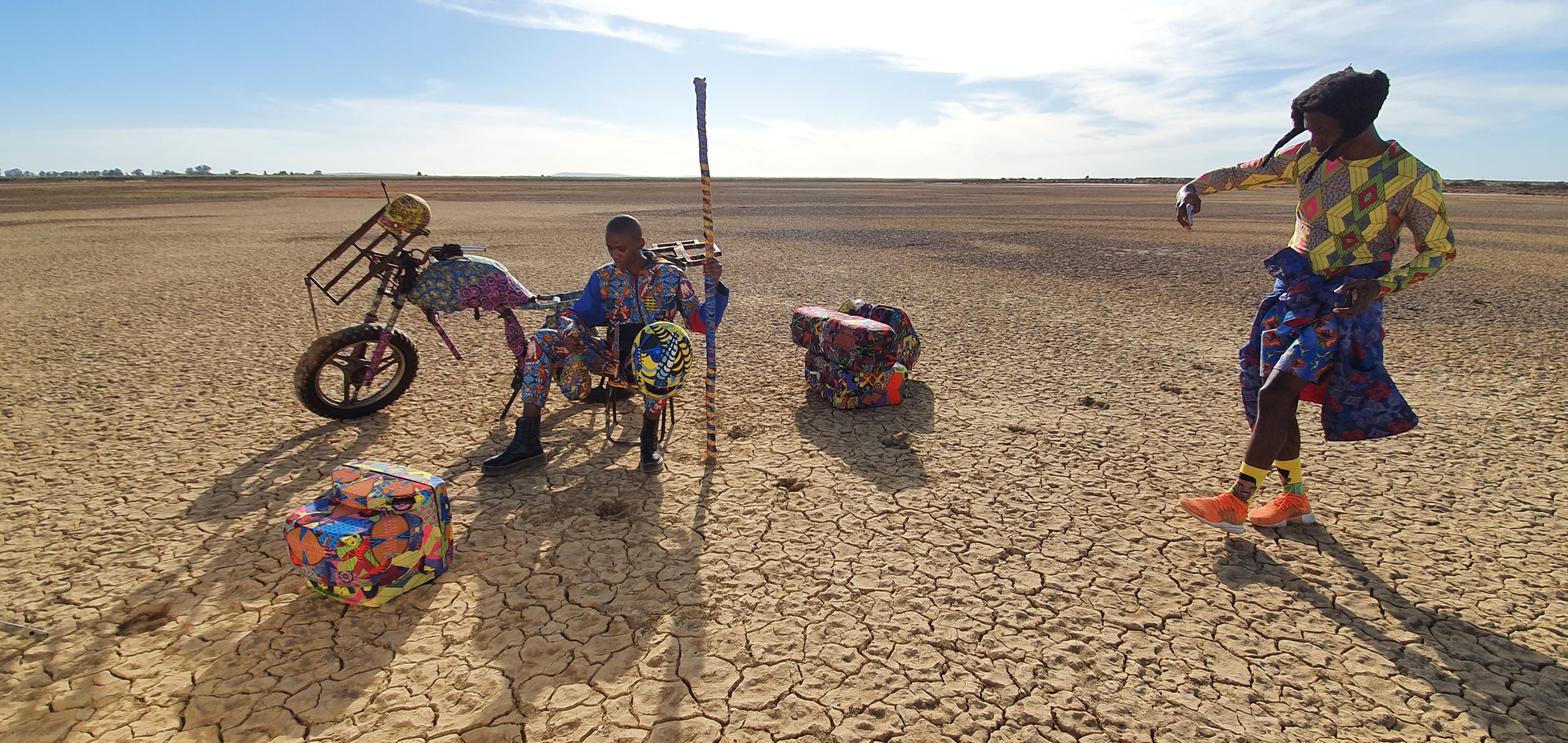
Behind the scenes. Nyambo MasaMara, Beyond Borders, 2021 (Photograph supplied)
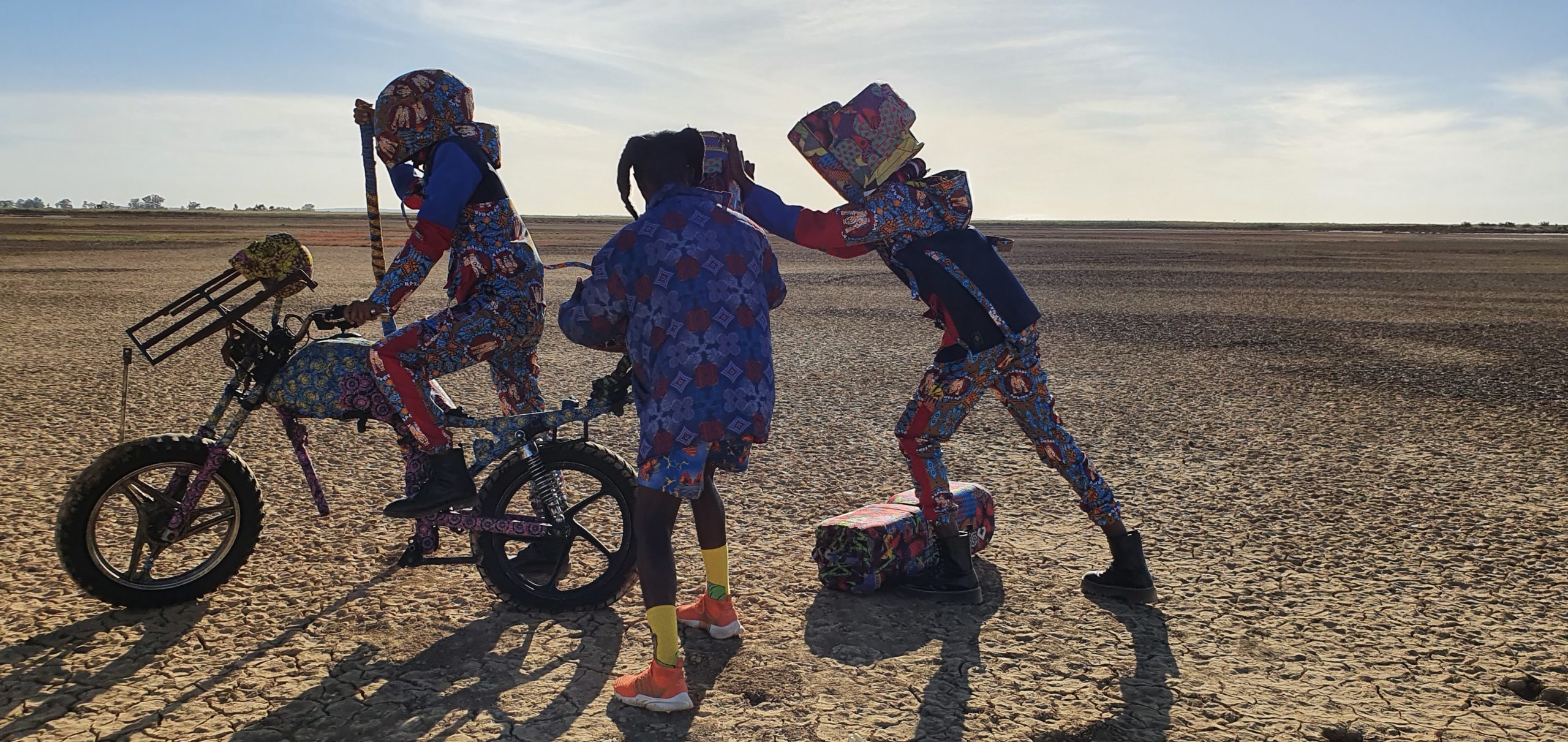
Behind the scenes. Eli Gold and models. Nyambo MasaMara, Beyond Borders, 2021 (Photograph supplied)
With a ball of barbed wire at the base and shreds of torn fabric enmeshed, the message of barriers to entry, refusal from refuge, takes shape as a profound social commentary on the plight of the refugee (discarded like detritus, like refuse). The hollow jacket (the metonymy for the refugee) rises above the cruel wire barrier and reaches endlessly skywards to a series of multicoloured orbs. A stirring mix of brutality and pain, the work has an uplifting message of triumph and resilience, in the concatenation of colours, patterns and, ultimately, optimism. The piece is still on show at Zeitz MOCAA until the end of October 2021.
Gold’s latest body of work takes the journey of the dispossessed/possessed one step further, to a spiritual realm. Consisting of four photographs and seven sculptures – three torsos, a motorbike and three skulls – the exhibition, Beyond Borders, is part of a group exhibition at the new Jaffer Modern in Green Point titled Art of Everyday Things. Eli was invited by the curators to exhibit his fashion work but it became the artist’s debut instead.
In Beyond Borders the viewer is taken on a profound journey of the soul, where the alluring vestments of fashion are discarded for a carapace (moulded from MasaMara fabric) – a body shield that protects his travellers, and their spiritual totems, from adversity. In this body of work the journey morphs into an Afro-futurist, potentially dystopian statement, where the traveller, the nomad, is placed in an indefinable Earth landscape, cracked and barren.
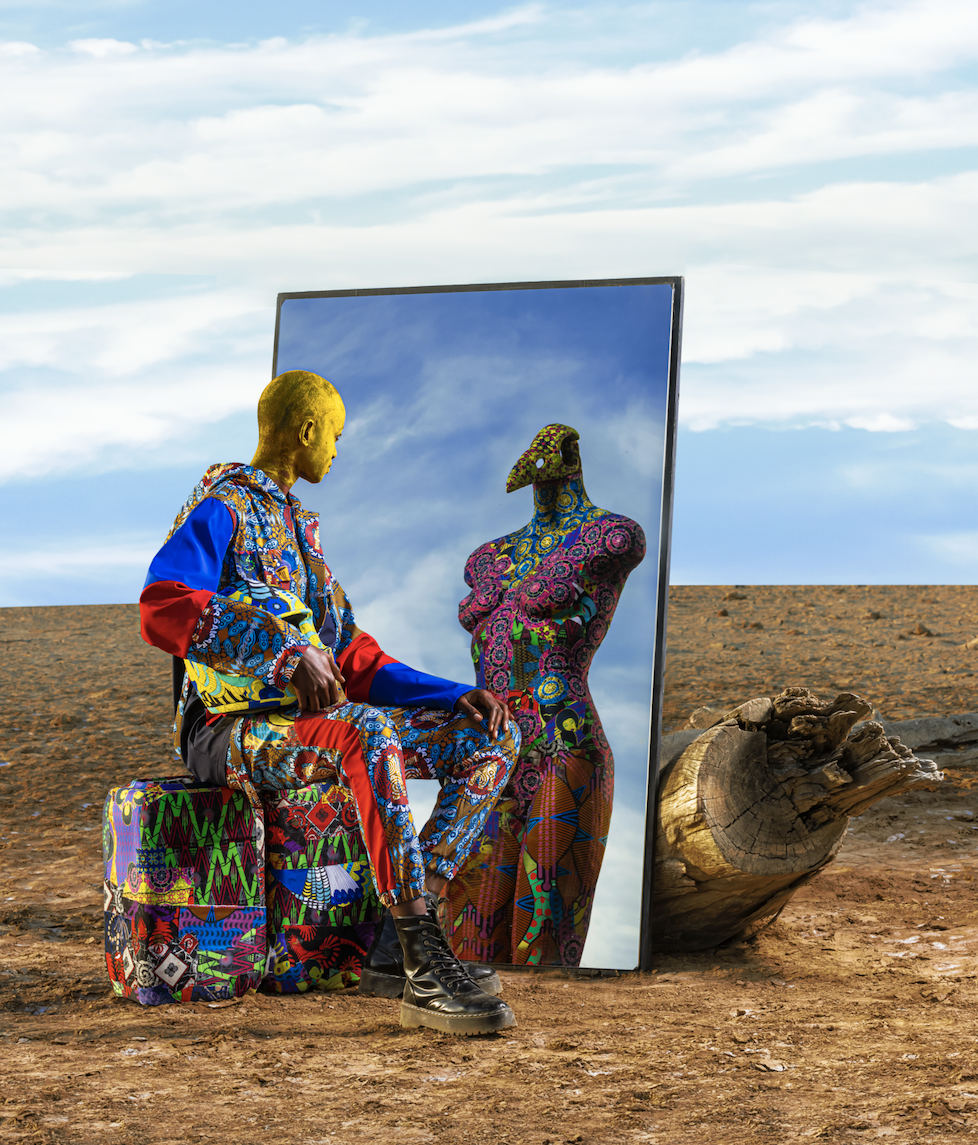
NYAMBO MASA MARA. Beyond Borders. ‘Maso Yerekwa – The Seer’, 2021 (Photograph supplied)
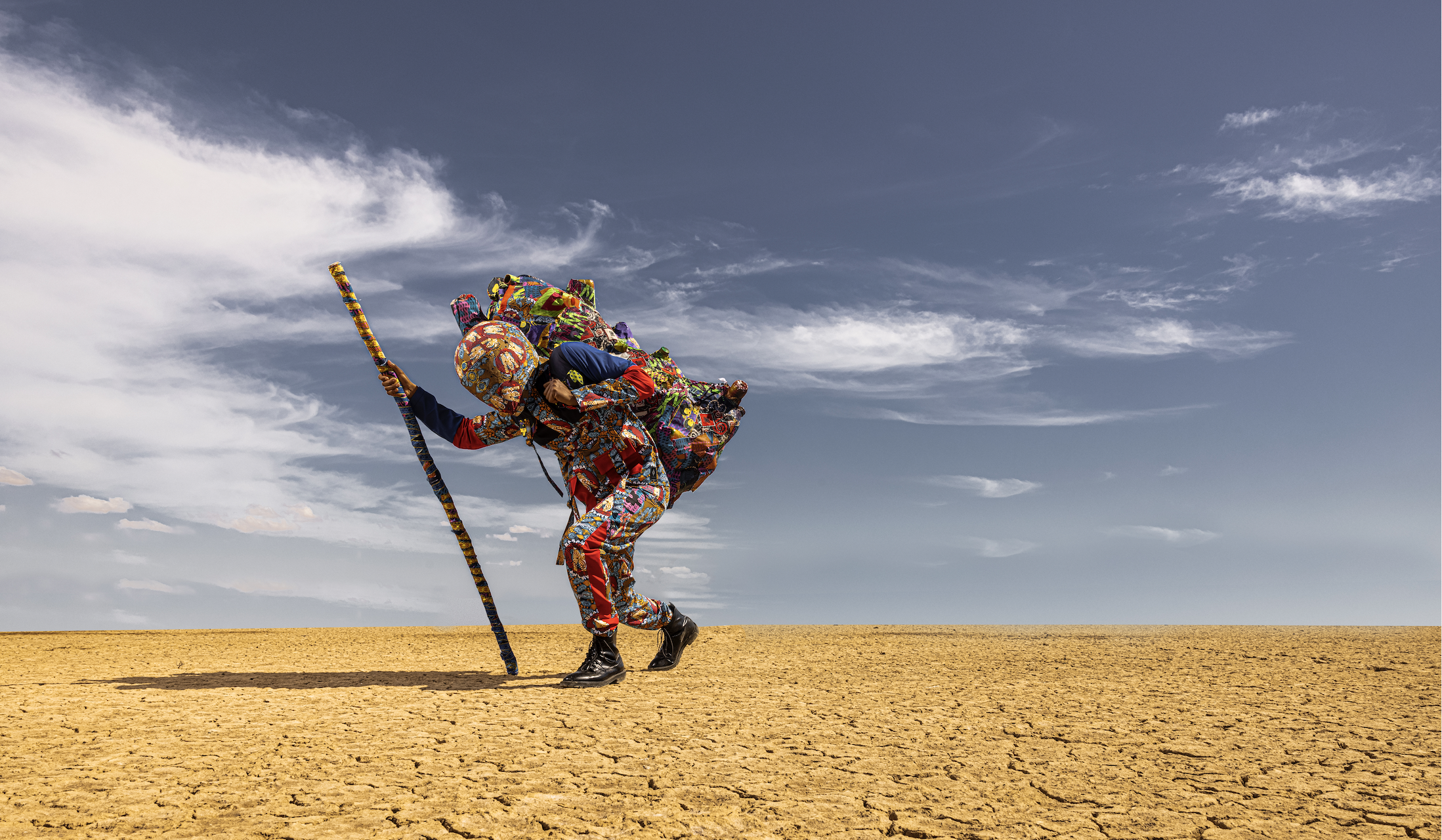
Nyambo MasaMara, Beyond Borders, ‘The Traveller’, 2021 (Photograph supplied)
The first photograph, Umhambi, (the Traveller), depicts a lone traveller, clad in a work suit, with a helmet completely obscuring the face, bent double with the weight of his/her/their undertaking, and baggage. Piercing white (sun)light breaks through the clouds behind (him), almost pushing the traveller forward, or downward, driving the traveller on the journey to a new land, filled with promise.
The second image depicts two travellers, on a motorbike, in the red, cracked no-man’s land. One is pushing the overladen bike. The other rides it. All characters in the image – human and objects – are covered in the signature fabric, including the baggage and the motorbike.
In the third photograph, one of the travellers sits on a chair in the wasteland, and remonstrates with a relic of another era, a bulbous television set – information, knowledge, depiction, real, unreal… Can the traveller truly discern reality from myth, hope, the promise of a better future? As the artist elaborates: “On the journey, the traveller picks up people, knowledge, information. Good and bad.” The traveller (the young artist?) needs to sift through it, all. Hopefully emerging wiser, rising above adversity, but never free of the pain endured during the adversity.
The final image in the series shows the traveller unmasked staring into a mirror. A haunting spectre reflects back at the traveller. This is Maso Yerekwa (The Seer). The artist notes: “Once you take that step (beyond the borders), you get to see your true self – understand who you are and who you are meant to be. Who you see there, might not be the one others want to see, or what you were expecting to see reflected back at you. This is not an easy journey.”
From the flat plane to three-dimensional sculptures: On the gallery floor is the actual motorbike – a spectacular sculpture fully encased in the signature colour shield. The haunting spectres from the photographs are now sculptured torsos covered in the same eponymous shell – each one a reified spirit of travel.
The first sculpture, entitled The Closer to the Sun I Travelled, comes from a Rwandan proverb – Akanyoni katagurutse Ntikamenya Iyo Bweze is a helmeted torso bearing the baggage, and orb-shaped symbols of hope and promise. As the artist explains, with another proverb: “‘The bird that doesn’t fly does not know where the wheat grows’. Sometimes you go to look for wheat – or a better life, or future – and you get there… and it is not as promised.”
With the second torso, the figure is encumbered by the symbols of knowledge, or, more precisely, information. A television set replaces the head. Titled One eye on Information… one eye in the soul, it speaks of: “How we can travel around the world without moving but get to stand in shoes of those everywhere – we can see what’s happening in Congo, Sudan… everywhere. But you have to be careful, because what you see is not necessarily what is there.”
The final torso is different in bulk: “Mugongo Wahetse Intore (The back that carried the Chosen one) is superficially less encumbered. A female torso is struck through with spears. A small skull hovers above the figure. “She is,” the artist explains, “the shield protecting the warrior. She bears a calabash on her back (the ‘Chosen One’). In Rwandan culture, to break the calabash is to bring bad luck: When it breaks you curse yourself. She is shielding the calabash – the Chosen One. All the spears coming through her. She is not moving. She is standing still, protecting what is being protected.”
And the motorbike is the Spirit-Rider – the driving force of the spirit. As the artist explains:
“This is the travelling spirit that existed – and is still in existence. I wanted to show what happened to the Spirit through the journey; what caused the Spirit to move from place to place. This is all decoded in each of the works.”
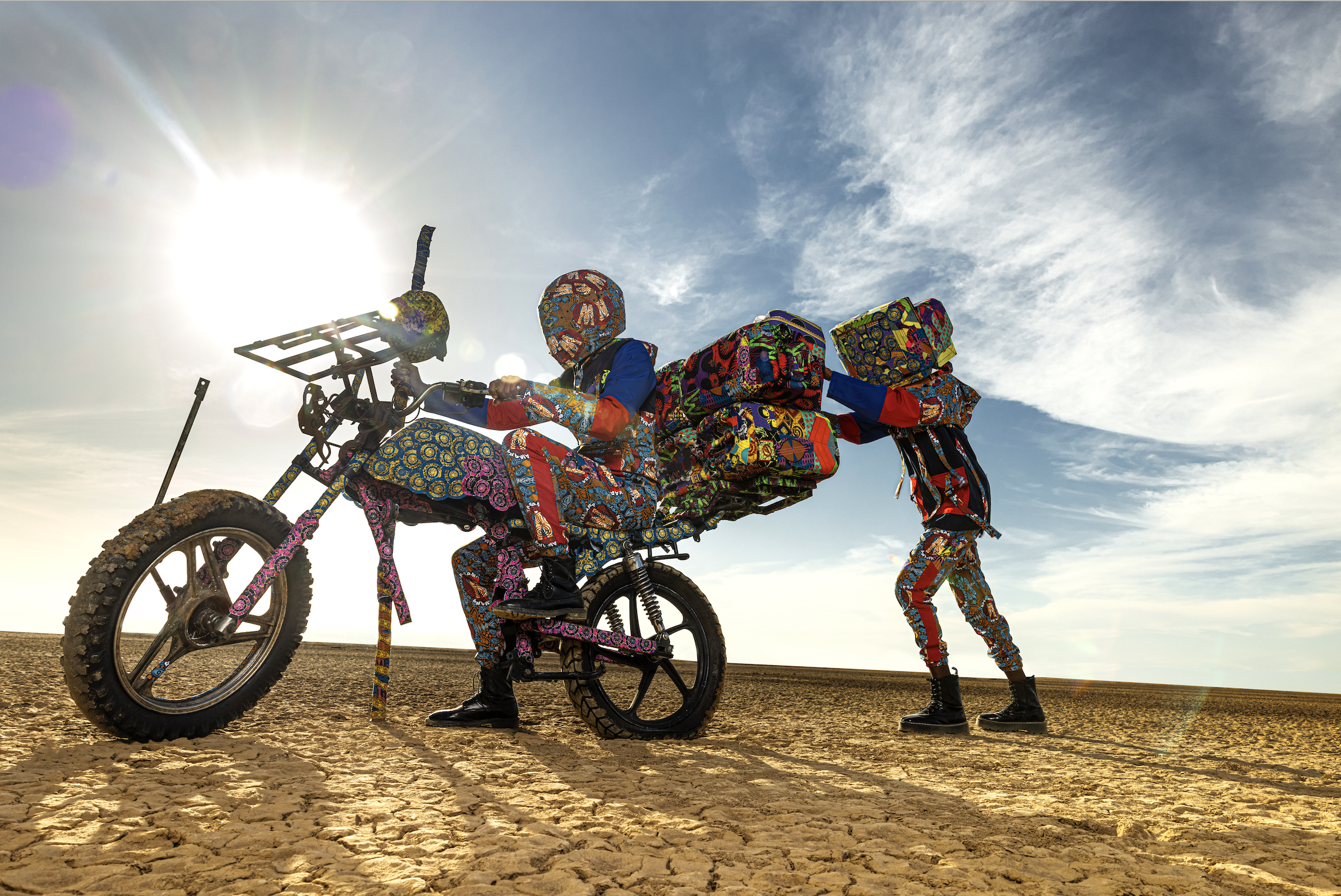
Nyambo MasaMara, Beyond Borders, ‘Spirit Rider’ 2021 (Photograph supplied)
What started as a lyrical celebration of a brilliant young talent rising above his background, surpassing his peers with his unique ability for creating pan-African couture, has taken the admirer of the designer MasaMara on a blindingly spectacular but deeply haunted journey across the continent – and Beyond Borders, physical and metaphysical.
Where once clothes adorned, where once the sun shone brightly over kaleidoscopic fabrics for stylish photoshoots, now hovers a piercing light of truth through the clouds, beating down on a harsh, barren world where the essence of the spirit pushes forward, undaunted, protected by a symbolic, high-colour pan-African uniform, a protective shield.
The spirit of the African traveller is confounding, tortured, but also declamatory, resilient, triumphant, beautiful and whole. The calabash, like the spirit, is fragile but unbroken. DM/ML

















 Become an Insider
Become an Insider
Comments - Please login in order to comment.